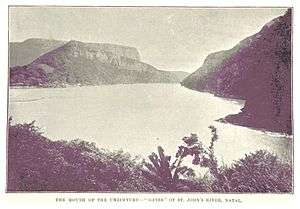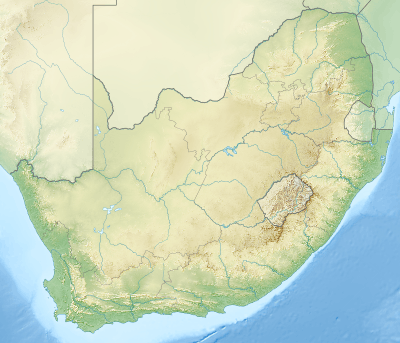Mzimvubu River
Mzimvubu River or Umzimvubu River is one of the most important rivers in South Africa.[2] It is located in the Eastern Cape Province.
| Mzimvubu River Umzimvubu River | |
|---|---|
 The Mzimvubu "gates" | |
 Location of the Mzimvubu River mouth | |
| Etymology | Meaning "place of the hippopotamus" in the Xhosa language[1] |
| Location | |
| Country | South Africa |
| Province | Eastern Cape Province |
| Physical characteristics | |
| Source | |
| • location | Drakensberg, Eastern Cape |
| • elevation | 2,050 m (6,730 ft) |
| Mouth | Indian Ocean |
• location | Port St. Johns |
• coordinates | 31°37′S 29°32′E |
• elevation | 0 m (0 ft) |
| Length | 250 km (160 mi) |
| Basin size | 19,853 km2 (7,665 sq mi) |
| Basin features | |
| Tributaries | |
| • left | Kinira, Thina, Tsitsa |
| • right | Mzintlava |
Course
The river has its source in the northern region of the Eastern Cape, in the area of Matatiele and Mount Fletcher near the Lesotho border. The Mzimvubu flows with twists and turns generally in a southeastern direction and flows into the Indian Ocean through an impressive gorge known as the "Gates of St John" into an estuary located at Port St. Johns. It is approximately 400 km long with a catchment area of 19,853 km².[3]
Although it is one of South Africa's major rivers, the Mzimvubu and its basin are largely undeveloped. Presently this river is part of the Mzimvubu to Keiskamma Water Management Area.[4]
History
In 1635 Portuguese ship 'Nossa Senhora de Belem' ran aground at the mouth of the Mzimvubu River.[5]
The Mzimvubu River divides Pondoland into an Eastern and Western Pondoland.[6] Formerly the river mouth was used as a harbor, but this activity was abandoned in the 1940s when the estuary became too shallow for large vessels owing to siltation and the fact that the entrance is sometimes obstructed by sand. Presently the estuary is river is navigable only for small craft for about 10 km upriver.[7]
Tributaries
The main tributaries of the Mzimvubu River are the Tsitsa River, the Thina River (Tina), the Kinira River and the Mzintlava River.[8]
Ecology
Some of the fishes caught in its waters are Oncorhynchus mykiss, an introduced species, Barbus anoplus and Anguilla mossambica; others, such as Micropterus salmoides and Cyprinus carpio, are invasive species.[9]
References
- South African Languages - Place names
- Key rivers of South Africa Archived 2012-07-10 at Archive.today
- "vn Rivers - Mzimvubu river". Archived from the original on 2008-12-27. Retrieved 2012-03-26.
- Is there a role for traditional governance systems in South Africa's new water management regime?
- Mpondo Kingdom - The History of The Kingdom Archived 2013-07-04 at the Wayback Machine
- Contributions to the ecology of Maputaland, Southern Africa
- van der Merwe, E. and Costello, K. Port St. Johns, "Paradise in Pondoland" (2nd edition).
- Mzimbuvu to Keiskamma WMA 12
- FROC - Reference frequency of occurrence of fish species in South Africa
External links
| Wikimedia Commons has media related to Mzimvubu River. |